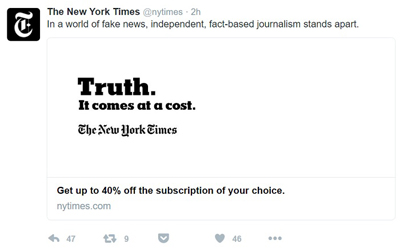A version of this Op-Ed appeared in Israel Hayom on April 2, 2017.
Does The New York Times report facts accurately?
That’s a question now much in the political limelight — and it got an astonishing response from a fellow journalist at the Washington Post. The premise of the piece is neatly summarized by its headline, which asks: “If the New York Times is so inaccurate, where are all of its corrections?” That is, the author thinks Times accuracy should be measured by the number of corrections it runs.
If so, everything in Pravda, a Soviet propaganda newspaper not known for its meticulous corrections policy, must have been completely accurate. And perhaps the sun really does revolve around the earth, since the Roman Inquisition never published a correction after condemning Galileo for saying the opposite.

A New York Times advertisement on Twitter promises “fact-based journalism.”
It’s stunning that an analysis, especially one by a professional correspondent at a leading newspaper, would fail to entertain the possibility that errors can (and do) go uncorrected. The number of confessions does not equal the number of crimes. If the Washington Post article aimed to prove the press is beyond reproach, it instead showed that, among some journalists, the question of accuracy just isn’t treated seriously.
To really test for accuracy, you’d have to roll up your sleeves and examine the content of the articles themselves, not just the corrections. And in the case of The New York Times, a closer look at what’s been published in recent months shows that criticism of the newspaper is very much warranted, at least when it comes to certain contentious topics.
All too frequently, The New York Times misstates the facts in its coverage of Israel and the Palestinians. And it’s hard to escape the conclusion that the errors are politically motivated. Last December, for example, the news pages claimed that the Palestinian Authority officially calls for “two states for two peoples,” a phrase that refers to a Palestinian state alongside a Jewish state.
To which Palestinian official Nabil Shaath responds: “We will never accept this.” Top Palestinian leaders frequently make clear the government’s firm opposition to two states for two peoples. But New York Times editors have refused to correct the misstatement.
Several additional serious uncorrected errors appeared in another recent New York Times Op-Ed by Ayman Odeh, an Arab-Israeli politician. The article claimed about Israel that, “since the founding of the state, more than 700 new towns and cities have been built for Jews, while no new cities have been built for Arabs.” But evidence that this is false can be found in none other than The New York Times itself, which referred last December to “Rahat, a largely Bedouin city in the Negev Desert.” Israel built Rahat, along with a number of other towns, for its Arab citizens.
But opinion editors refused to correct the error, which was meant to cast Israel as oppressive toward its Arab minority, and even defended it by arguing that Rahat’s infrastructure is not equal to other cities — a comparison that does nothing to make the factual error any less false.
The same article claimed that Bedouin from the village of Umm al-Hiran seeking to live in a newly planned Israeli town were told that they couldn’t do so, because the town is to be “for Jews only.” Israel, though, never said such a thing. In fact, it had said the opposite: That the Bedouin were free to purchase plots in the town. Again, a New York Times news story acknowledged as much, straightforwardly reporting that “The government said Umm al-Hiran’s residents could purchase plots in the future town.”
Yet here again, opinion editors refused to correct an error portraying Israel as oppressive. And here again, they defended the falsehood nonsensically, explaining that the author of the piece doesn’t believe the government’s offer was genuine.
The author is welcome to believe whatever he wants. But he isn’t entitled to assert Israel said something when, in fact, it said the opposite. A person’s beliefs don’t nullify the facts. And any newspaper that fails to recognize this renders meaningless their promises of factual accuracy.
There have been plenty more uncorrected errors. A front-page story published just before inauguration day claimed that Donald Trump had “vowed to support Israel no matter what.” When asked when this promise was made, editors admitted they had no specific vow in mind. Editors refused to correct.
The same article falsely claimed that, after a recent meeting in Paris about the Middle East peace process, “countries issued a joint communiqué that reaffirmed support for … a return to the 1967 boundaries between the Israelis and Palestinians.” The communiqué in fact made no mention of the 1967 boundaries, nor any boundaries at all. Again, the newspaper refused to correct this fictional insertion, which happens to comport with the oft-expressed editorial position of The Times.
To be fair, The New York Times does sometimes publish corrections. But that doesn’t make the newspaper accurate, as the Washington Post analysis claimed. It makes it sometimes accurate.
“Sometimes accurate” is obviously not what serious newspapers promise readers. “It is our policy to correct our errors, large and small, as soon as we become aware of them,” an Ethical Journalism handbook published by The New York Times says. Meanwhile, in an ongoing ad campaign the newspaper casts i
tself as rising above the noise, relentless in its pursuit of “truth.”
tself as rising above the noise, relentless in its pursuit of “truth.”
But like its false claim that Palestinian leaders support two-states for two peoples, that President Abbas accepts a Jewish state, that Israel has built no cities for its Arab population, that the Israeli government insists a new town is for “Jews only,” and that a communiqué called for the 1967 boundaries, New York Times assurances that it is an antidote to fake news is, unfortunately, just another alternative fact.
